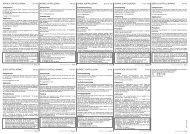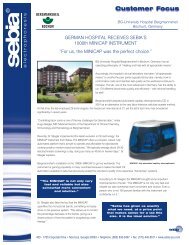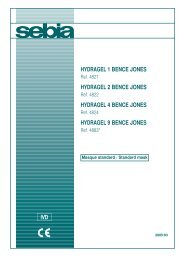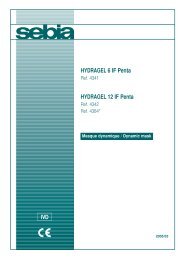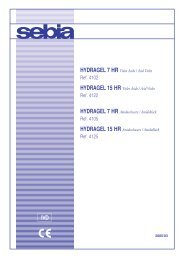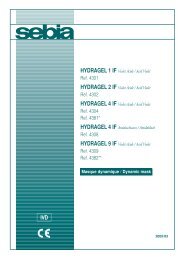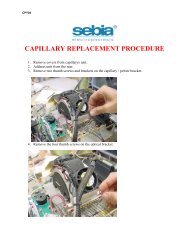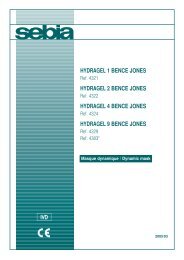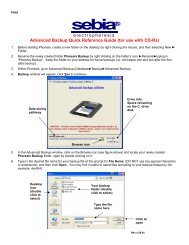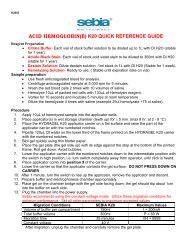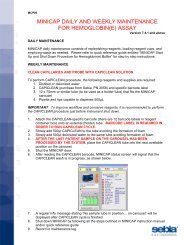CAPILLARYS HEMOGLOBIN(E)
CAPILLARYS HEMOGLOBIN(E) - Sebia Electrophoresis
CAPILLARYS HEMOGLOBIN(E) - Sebia Electrophoresis
- No tags were found...
You also want an ePaper? Increase the reach of your titles
YUMPU automatically turns print PDFs into web optimized ePapers that Google loves.
<strong>CAPILLARYS</strong> <strong>HEMOGLOBIN</strong>(E) - 2010/10<br />
QUALITY CONTROL<br />
After having changed the analysis buffer lot number or the technique, or after a cleaning sequence with CAPICLEAN, and before starting a new<br />
analysis sequence, it is necessary to run two analysis sequences with the Normal Hb A2 Control, SEBIA, PN 4778, and the sample rack No. 0<br />
intended for control blood sample (see paragraph REAGENTS REQUIRED BUT NOT SUPPLIED).<br />
It is also advised to include into each run of samples, an assayed control blood (for example, a blood sample containing hemoglobins A, F, C and S,<br />
such as Hb AFSC Control, SEBIA, PN 4792, or a normal blood sample, the Normal Hb A2 Control, SEBIA, PN 4778 or the Pathological Hb A2 Control,<br />
SEBIA, PN 4779).<br />
IMPORTANT: For optimal use of the blood controls analyzed with the <strong>CAPILLARYS</strong> 2 FLEX PIERCING system, it is necessary to use the specific<br />
conical tubes for controls and their corresponding caps, the wedge adapters for tubes for controls (see EQUIPMENT AND ACCESSORIES<br />
REQUIRED) and the bar code labels intended to identify the tubes for controls that contain the blood control to analyze (see the paragraph "Normal<br />
Hb A2 Control" for the utilization of a wedge adapter for tubes for controls).<br />
* US customers : Follow federal, state and local guidelines for quality control.<br />
RESULTS<br />
Values<br />
Direct detection at 415 nm in capillaries yields relative concentrations (percentages) of individual hemoglobin zones.<br />
Reference values for individual major electrophoretic hemoglobin zones in the <strong>CAPILLARYS</strong> 2 FLEX PIERCING system have been established from<br />
a healthy population of 113 adults (men and women) with normal hemoglobin values using HPLC technique:<br />
Hemoglobin A : comprised between 96.8 and 97.8 %<br />
Hemoglobin F : < 0.5 % (*)<br />
Hemoglobin A2 : comprised between 2.2 and 3.2 %<br />
(*) See Interference and limitations<br />
It is recommended that each laboratory establish its own threshold values.<br />
NOTE: Reference values have been established using the standard parameters of the <strong>CAPILLARYS</strong> software (smoothing 0 and hemoglobin fractions<br />
automatic quantification with <strong>HEMOGLOBIN</strong>(E) analysis program).<br />
WARNING: Reference values must be considered only when hemoglobin variants are absent.<br />
Interpretation<br />
See ELECTROPHORETIC PATTERNS, figures 1 – 17.<br />
The different migration zones of hemoglobin variants (called Z1 to Z15) are shown on the screen of the system and on the result ticket. Passing the<br />
mouse cursor over a zone name displays icon information containing possible hemoglobin variants that could be seen in this zone.<br />
For each fraction, the maximum position defines the migration zone.<br />
See the table showing the potential variants located in each zone.<br />
WARNING: The graduation of the horizontal axis does not allow, in any case, the identification of an hemoglobin variant.<br />
1. Qualitative abnormalities: Hemoglobinopathies<br />
Most hemoglobinopathies are due to substitution by mutation of a single amino acid in one of the four types of polypeptide chains (1, 2, 4, 9, 12) . The clinical<br />
significance of such a change depends on the type of amino acid and the site involved (13) . In clinically significant disease, either the α-chain or the<br />
ß-chain is affected.<br />
More than 900 variants of adult hemoglobin have been described (6, 14) . The first abnormal hemoglobins studied and the most frequently occuring have<br />
an altered net electric charge, leading to an easy detection by electrophoresis.<br />
There are five main abnormal hemoglobins which present a particular clinical interest: S, C, E, O-Arab and D.<br />
The <strong>CAPILLARYS</strong> <strong>HEMOGLOBIN</strong>(E) kit is intended for the identification of hemoglobinopathies and thalassemias.<br />
Hemoglobin S<br />
Hemoglobin S is the most frequent. It is due to the replacement of one glutamic acid (an acidic amino acid No. 6) of the ß-chain by valine (a neutral<br />
amino acid): when compared to Hb A, its isoelectric point is elevated and its total negative charge decreased with the analysis pH. Its electrophoretic<br />
mobility is therefore increased in the capillary and this hemoglobin is faster than A fraction. With alkaline buffered <strong>CAPILLARYS</strong> <strong>HEMOGLOBIN</strong>(E)<br />
procedure, hemoglobin S migrates between A and A2 fractions, next to Hb A2.<br />
Hemoglobin C<br />
One glutamic acid of the ß-chain is replaced by lysine (a basic amino acid No. 6): its mobility is strongly reduced. When compared to Hb A, its<br />
isoelectric point is highly elevated and its total negative charge decreased with the analysis pH. Its electrophoretic mobility is therefore increased in<br />
the capillary and this hemoglobin is faster than A fraction which allows its differenciation. Hemoglobins C, E and O-Arab are not superimposed on the<br />
electrophoretic pattern and are easily identified.<br />
Hemoglobin E<br />
One glutamic acid of the ß-chain (No. 26) is replaced by lysine. With <strong>CAPILLARYS</strong> <strong>HEMOGLOBIN</strong>(E) procedure, hemoglobin E migrates just<br />
anodically behind hemoglobin A2 and is totally separated from it. Then, when hemoglobin E is present, A2 fraction can be measured to detect<br />
ß thalassemia.<br />
- 50 -



